
|
Sigma 50-500 mm F/4.0-6.3 DG Lens Here comes the Bigma |

|
My other articles related to the |
|
After having written the first part of this article (general information and specs), I've put it on the shelf, having decided not to buy this lens anyway (I am not that much of a birder). And then, one day in 2008, a friend said: "Would you like to try my Bigma out? My son was not able to get single sharp frame out of it, neither have I. The lens was sent to factory service, and even this did not help." Well, what could I say? I took the lens home, used it for a month, and got about 600 frames out of it (mostly on my E-510). Now, a year later, I found some time to go through all those images and to finish the review. Introduction While there is a quite wide choice of lenses available in the Four Thirds mount for the Olympus E-System cameras, most of the longer ones are premium glass — top quality but ridiculously expensive. How does $6000 for a 300 mm F/2.8 sound? While I've met some people who actually bought that lens, I'm sure I won't be able to afford it in the predictable future. The longest Four Thirds lenses available until 2008, for us mere mortals, were two zooms: the Olympus 50-200 mm F/2.8-3.5 ZD (now updated to the second version) and Sigma 55-200 mm F/4.0-5.6 DC (a bargain at $150 but not a match for the 40-150 mm Olympus kit zoom, new or old). Both offer the longest equivalent focal length (EFL) of 400 mm, i.e., a field of view similar to that obtainable on a full 34×36 mm film frame with a 400 mm lens. Then in 2008 Olympus released the 70-300 mm F/4.0-5.6 ZD (designed and, most probably, manufactured by Sigma), a surprisingly well-behaved lens at a most attractive price. This brought the EFL available to most E-System users up to 600 mm. Now, that is plenty. How many of us have used lenses above 400 mm with their film cameras? Still, for some applications longer lengths may be (or, at least, seem) desirable, wildlife and sports photography being two obvious examples. Enter the Bigma. Among the enthusiasts, this is the affectionate name assigned to the Sigma 50-500 mm F/4.0-6.3 DG lens. Sorting out the alphabet soup The full name of this lens as passed to the camera and reported in the EXIF data is Sigma 50-500 mm F4.0-6.3 EX DG APO HSM RF. Even the manufacturer seems to be confused by this acronym list, referring to the lens differently in the product page, lens chart, and on the lens barrel itself (where it says just APO DG HSM). To sort this mess out, let me quickly explain what all these abbreviations mean:
Out of all these, only the last acronym is really meaningful, because it can be used to tell this lens apart from its pre-digital version, which did not carry the DG designation. It should not be confused with DC, which is used by Sigma for lenses designed to cover the smaller APS-C format. In those, the designers can worry only about the performance within the smaller circle, but the resolution within that circle has to be higher than in a full-frame lens, as required by higher magnification of the generated image for viewing and printing. The "old" (non-DG) Bigma has been around since 2001 or so, and has proven itself as a good (for the price) and inexpensive (for the specs) optics. The new model, announced in 2005, became available in the United States only in September the next year. An obvious question: did Sigma simply repackage the older lens as "digital", or is it really a new design? A Reader from Germany was able to compare both version in the Nikon mount; he found them to be identical externally, with the only difference being a different-colored coating on one of surfaces. All specifications are also identical: size, weight, number of groups and elements. Sigma will not say what, if anything, else was changed in the transition to the DG version, so I'm assuming that, indeed, the older lens has been re-packaged for digital cameras, perhaps improving the multi-coating, as that is more critical with digital sensors (which are more reflective than film). Two questions however, remain open:
I will try to answer both these questions, based a few hundred images shot with this lens, later in this article. Specifications Here are full specifications, mostly as given by Sigma:
Note that the lens offers a very wide 10:1 zoom ratio. While this would be worrisome for a wide-to-tele lens (unavoidable compromises in optical quality, like in most EVF cameras), here the short end of the range is well longer than the "normal" focal length, so this may be not so painful. On the other hand, this makes make lens changes less frequent if you are not carrying two bodies. Some reports say the actual maximum focal length is about 470 mm (a tad outside the traditional 5% tolerance used by manufacturers in marking their lenses). I haven't done any measurements to confirm or deny that. With long (narrow-angle) lenses becoming more available for digital cameras than they were for 35-mm film ones, we can witness more inexperienced photographers using them, and usually with not-so-satisfactory results. The Bigma will be no different here. We have to remember that a 1000 mm EFL lens is not something for a general use. While it will allow to bring closer distant subjects, and to isolate them with limited DoF, it requires more attention when shooting. (If you are not sure what DoF, or Depth of Field is, and on what it depends, you certainly are not ready for a long lens. Not yet.) First of all, the depth of field is very limited. For example, when shooting wide open at F=500 mm and with the main subject 10 meters away, the DOF extends just by one centimeter or so ahead and beyond the focused distance. Expect to have lots of badly-focused pictures. Second, any camera shake will be greatly exaggerated with this focal length. You have to use faster shutter speeds to avoid camera shake with longer focal lengths; for 500 mm, 1/1000 s is a reasonable limit — unless you have a steady hand and a good shutter release technique (but remember, this mama is quite heavy, so your hands will be tiring fast). Of course, a tripod is recommended here; the heavier the better. Third, under less-than-ideal weather conditions the atmospheric haze may become objectionable, especially if the lens is used for subjects 200 meters or more away. This is in addition to lower contrast, usually a fact of life with longer lenses. Last but not least, the perspective provided by long lenses is not suitable for all objects; it is greatly compressed along the lens axis. This may be fine for single subjects isolated out of the background, or as a special effect (the often-overused shot of cars sitting on top of each other on a crowded highway), but not for general use. It is like writing your emails in all caps. If you remain undeterred, you have also to remember that the longer focal lengths will come useful in only a few applications, with wildlife and field sports coming first to mind. For anything else, a shorter tele zoom (like the inexpensive but very nice 40-150 mm ZD from Olympus) will serve you much better. Still want to buy a Bigma? Be prepared to shoot a lot, and to reject a great majority of frames. Of the remaining ones, some may be real keepers. Consider yourself warned. Make, finish, and handling Yes, the lens is heavy. At four pounds, it certainly helps the photographer to develop extra muscle mass. This is, however, to be expected at these focal lengths. The matte Sigma EX finish is quite nice; there is a distance scale provided (if not really helpful at this depth of field). Zooming all the way in extends the lens by an extra 2/3, as expected. The zooming action is not really smooth, but this can be expected, with the cams having to move all this glass. There is a mechanical zoom lock, handy in preventing zoom creep. The front element does not rotate during focusing, neither does the lens length change. The included tulip hood (reversible for storage) has a nice touch: a fuzzy black velvet surface inside. This should be helpful in reducing the stray light reaching the front lens surface, and a good hood is the most important lens accessory money can buy, especially for long lenses. I would like to see this feature more often, even if it increases the production cost by 25 cents or so. The tripod ring has a carrying handle and can be easily detached from the lens. |
|
Yes, indeed, a tripod. This focal length magnifies any hand shake by a factor of 20× as compared to the "standard" 50 mm EFL (25 mm on Four Thirds), and with this bulk and weight your hands may shake a lot. Still, unless you shoot your birds at a feeder, shooting from hand is so much easier, that (except for some sample images) I ended up handholding the Bigma all the time. This means using the lens in good weather, setting the ISO as high as you dare (I used ISO 400 on the E-510), and activating image stabilization. (Poor users of Canon and Nikon cameras do not have this option, as these systems depend on in-lens IS.) At this weight and size there is no longer a problem of how well does the lens balance on the camera, as the lens is what you hold and support, and the camera just hangs on. As a matter of fact, I found that the smaller E-510 balances better on the lens than the E-3. Funny? Autofocus can be sometimes an issue. In good light, with contrasty detail to focus on, I found it to be OK; with less detail it would sometimes hunt in steps, accentuated with small thuds. I also suspect that the AF accuracy may be not too good — but this may be due to very shallow depth of field. Indeed, when doing a mug shot of a neighborhood squirrel six meters away at F/5.6, the DoF extends just one centimeter in each direction. It is possible that I can move this much between locking the focus and opening the shutter, or the squirrel does. Still, I have reasons to believe that the E-510 (or E-3) does not focus with the Bigma as willingly as with other lenses I've tried. This becomes a game of probabilities, therefore you should shoot five, ten times more than you think you need. This is, by the way, where I was missing the focus bracketing option, which was available on the E-500, and taken away in later Olympus models. Image samples As usually, I'm showing reduced full frames at the left to judge the exposure accuracy and to show the whole scene; a red outline shows from where the full pixel scale fragment at the right was taken. Remember that these fragments show the image magnified more than in a reasonably sized print size. On a typical, 96 dpi monitor they correspond to the full image printed to 72×96 cm (28×38"), which normally requires a viewing distance of 120 cm (47"). First, casual shots These were taken right after I picked up the lens, without a tripod — but with the image stabilization in my E-510 turned on, and with ISO raised to 400, to reduce camera shake. Aperture priority F/8 (-3 EV compensation) was used; the resulting shutter speeds are shown in captions. The in-camera sharpening and contrast were set to -2 in Natural mode, as I usually prefer to enhance them in postprocessing. For each focal length I shot three frames (with camera autofocusing anew every time), choosing the best one for more critical evaluation. |

|

| |
| 50 mm, 1/640 s | ||
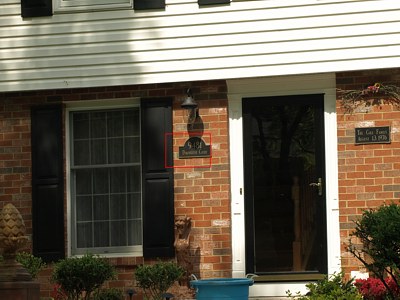
|

| |
| 107 mm, 1/640 s | ||
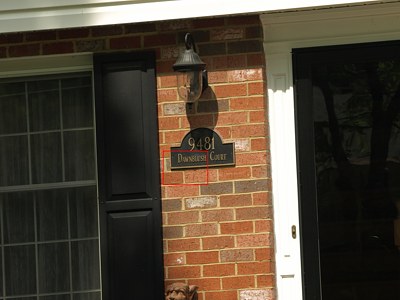
|
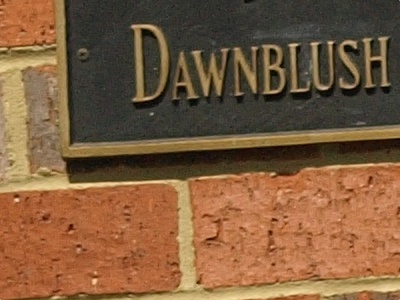
| |
| 208 mm, 1/640 s | ||
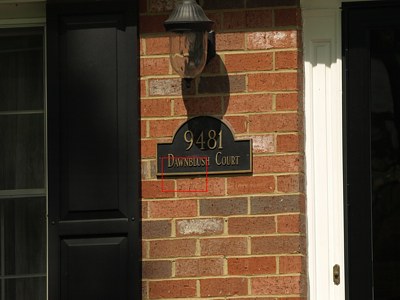
|
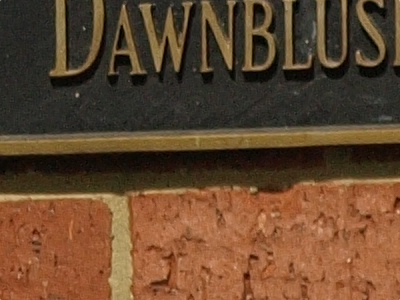
| |
| 313 mm, 1/800 s | ||
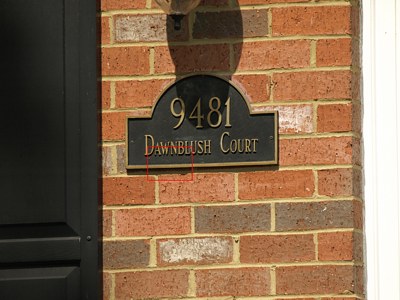
|
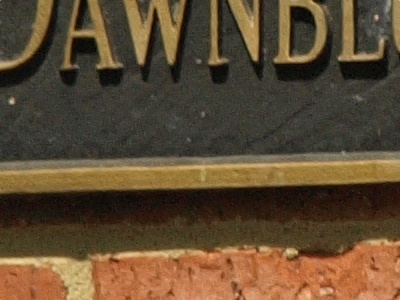
| |
| 500 mm, 1/500 s | ||
|
Well, what can I say? There is nothing to complain about here. At the short end the Bigma is quite sharp, improving at 100 and 300 mm, and still good, if slightly softer and less contrasty, at 500 mm (in addition to the sample being exposed a bit more than others, which magnifies that impression). Remember that in-camera sharpening is tuned way down, with none added in postprocessing; therefore my subjective evaluation is "good to very good". Obviously, the high-contrast detail allowed the camera to autofocus accurately, even if not in every single frame: I still had a few real duds to reject. Too bad I've missed the 400 mm focal length in this series. The Crofton Lake The house across the lake from mine makes a good sample subject. These images were taken from a tripod, ISO 100, aperture priority (-0.3 EV), sharpness and contrast at N-2 as before. Because of shallow dept of field, single-point AF was used, with the central point always within the fence area. This session included a total of 25 combinations of aperture and focal length: fully open and all full F-stops up to F/16; 50 mm and every 100 mm to 500 mm. (Focal lengths were dialed based on the ring scale; close but not quite at intended values.) For every combination I shot three independently focused frames, choosing the best one for scrutiny; this provided a reasonable protection against possible AF flukes. Comparing samples was not done by viewing them side-by-side, but by switching between full-screen fragments in an image browser; this catches even small differences. I've run the whole session twice (ISO 100 and 400); the results and trends were similar for both series. F = 50 mm |
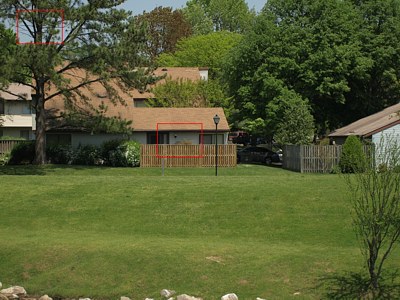
|
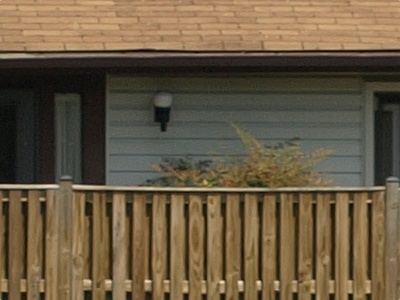
| ||
| [1a] 50 mm, 1/1000 s at F/4 | |||
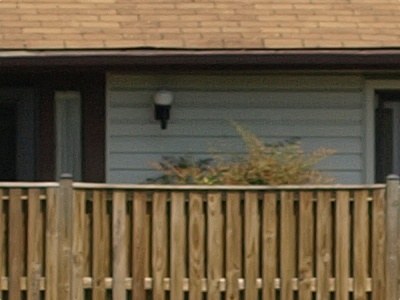
|
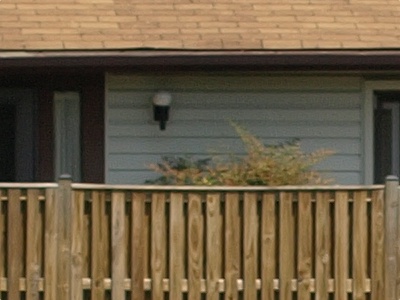
| ||
| [1b] 50 mm, 1/500 s at F/5.6 | [1c] 50 mm, 1/250 s at F/8 | ||
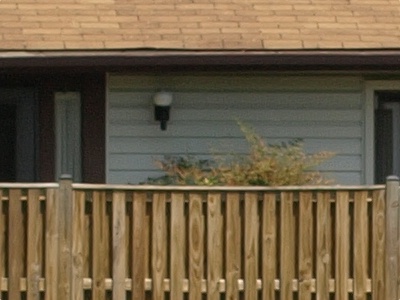
|
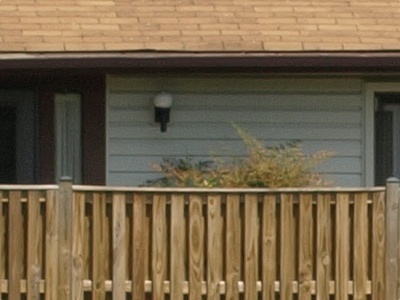
| ||
| [1d] 50 mm, 1/125 s at F/11 | [1e] 50 mm, 1/60 s at F/16 | ||
|
Overall, quite good results at 50 mm, with no significant dependency of image sharpness on aperture: I can see no improvement when initially closing it down, but also no degradation due to diffraction effects when getting to F/11 and beyond (well, maybe some at F/16). The latter means that other optical flaws are more significant in limiting the resolution than diffraction effects. The corners are not significantly worse than the center, even wide open. Chromatic aberration is well under control: see a corner sample from the full-aperture image, shown at right. Overall, a good performance for this type of lens at the short end. |
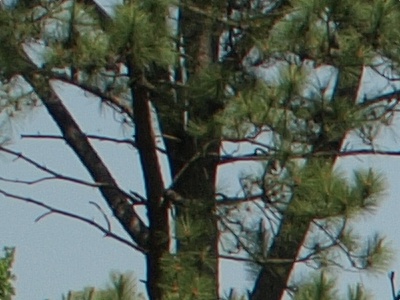
| ||
| [1a] 50 mm, F/4, corner | |||
|
F = 107 mm Let us now go to the focal length of 100 mm (or, more exactly, 107 mm, as this was what I got trying to dial 100 mm on the zoom ring). The maximum lens aperture at this focal length is F/5.3. |
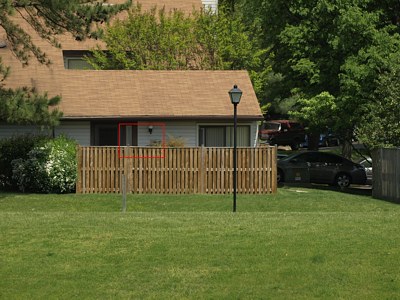
|
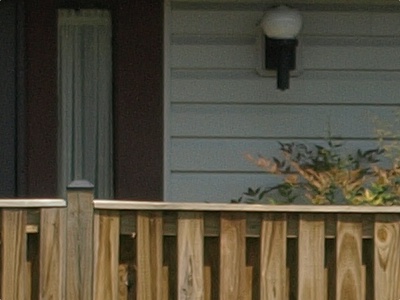
| ||
| [2a] 107 mm, 1/640 s at F/5.3 | |||
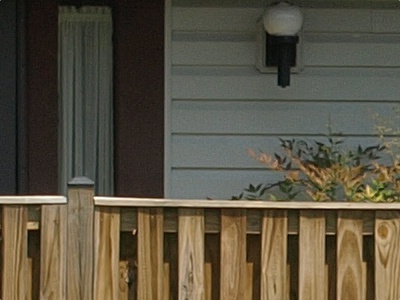
|
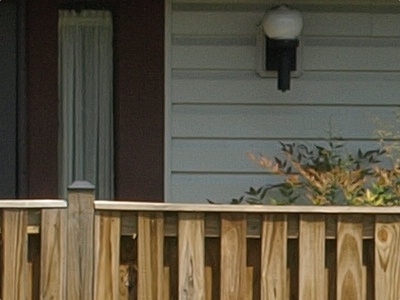
| ||
| [2b] 107 mm, 1/250 s at F/8.0 | [2c] 107 mm, 1/125 s at F/11 | ||
|
This looks better to me than 50 mm. The detail improves at F/8, and drops off (as contrast does) only at F/16 — quite as expected.
I consider this a very good performance. If you would like to scrutinize a full frame at F/8 (out-of-camera JPEG, not altered in any way), click here (6.4 MB). |
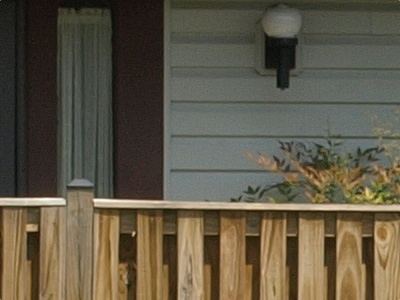
| ||
| [2d] 107 mm, 1/60 s at F/16 | |||
|
F = 208 mm Next, let us have a look at 200 mm (or, more exactly, 208 mm), where the maximum aperture is F/6.1. |
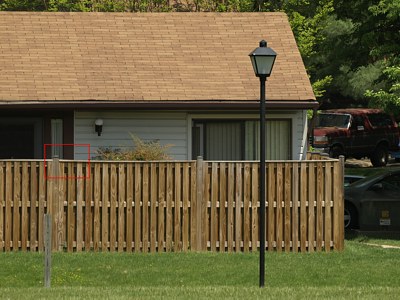
|
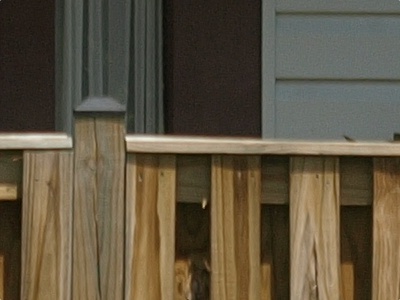
| |
| [3a] 208 mm, 1/400 s at F/6.1 | ||
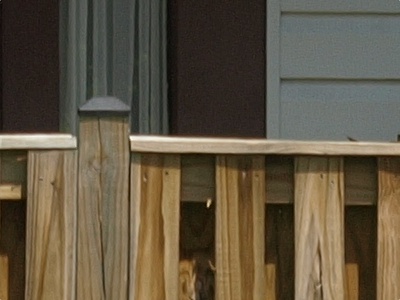
|
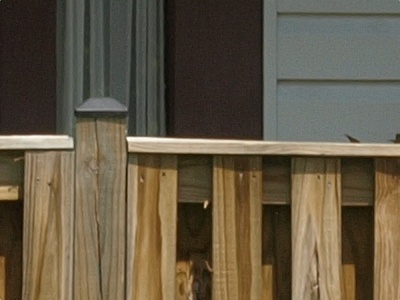
| |
| [3b] 208 mm, 1/250 s at F/8 | [3c] 208 mm, 1/125 s at F/11 | |
|
Clearly, at full aperture we are facing some problems with internal reflections, causing glare around highlights. This wouldn't be surprising around light sources, but here we see the effect under less demanding circumstances: the top of the fence right of the pole. (This is not just unsharpness, note that the darker wood structure is quite OK.)
This gets under control, along with general sharpness improvement, at F/8, and the lens seems to do best at F/11. At these apertures the lens delivers, again, very nicely. |
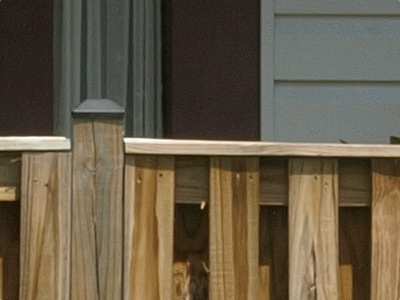
| |
| [3d] 208 mm, 1/60 s at F/16 | ||
|
F = 313 mm This is how close was I able to get, attempting to set the zoom ring to 300 mm. Before the arrival of the 70-300 mm ZD and the Bigma, this focal length was available to E-System users only with an exotic price tag (300 mm F/2.8 ZD) or by resorting to legacy lenses (no AF, stepped-down metering only). At this focal length, the lens full aperture is F/6.3, already the same as at 500 mm. |
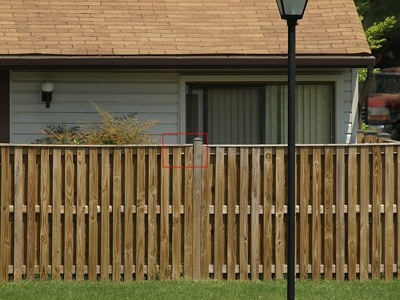
|
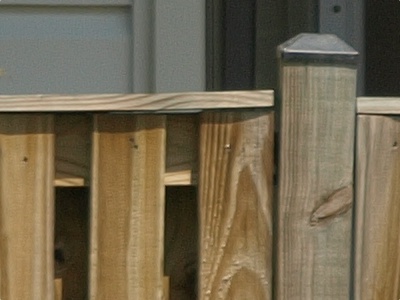
| |
| [4a] 313 mm, 1/400 s at F/6.3 | ||
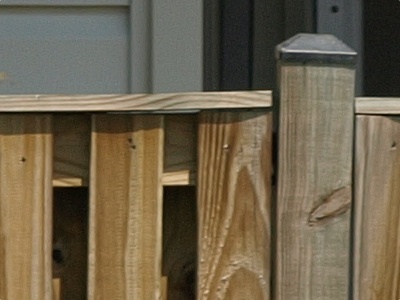
|
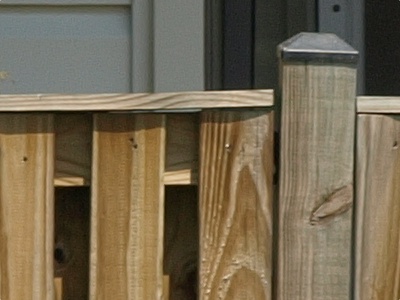
| |
| [4b] 313 mm, 1/250 s at F/8 | [4c] 313 mm, 1/125 s at F/11 | |
|
Similar to 200 mm; the lens will work better stopped down to F/8, with further (if slight) improvement at F/11. Diffraction effects at F/16 are already quite visible.
Do not allow pixel-peeping to fool you: this is still a solid performance. Have a closer look at the full original frame at F/8 (7 MB) and note that the corners are not much worse than the center. |
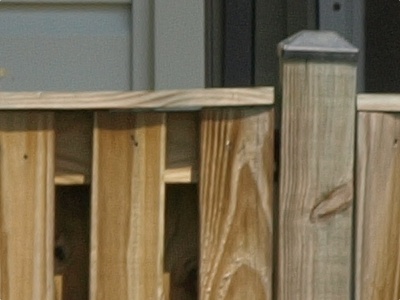
| |
| [4d] 313 mm, 1/60 s at F/16 | ||
|
F = 420 mm Now we are in the focal length range the Bigma has for itself (unless you use the 50-200 mm ZD with a 2× teleconverter). |
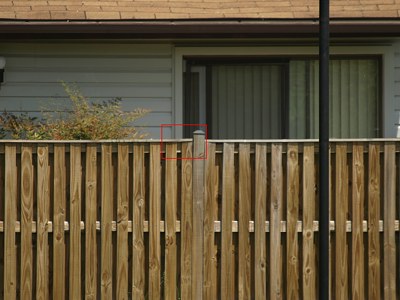
|
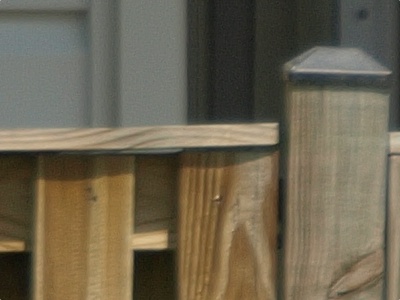
| |
| [5a] 420 mm, 1/400 s at F/6.3 | ||
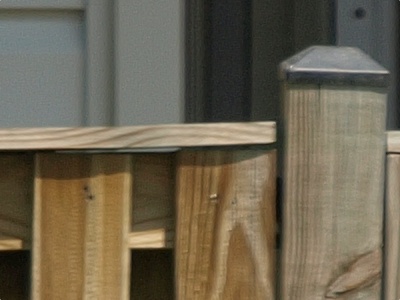
|
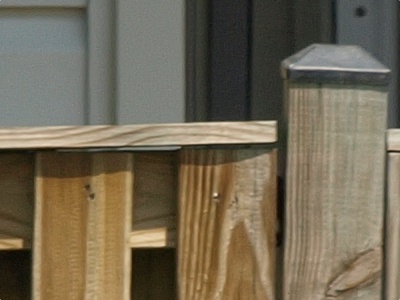
| |
| [5b] 420 mm, 1/250 s at F/8 | [5c] 420 mm, 1/125 s at F/11 | |
|
The F/8 sample [5b] seems to be suffering of camera shake (even if it was the best of three; obviously, my tripod was not heavy enough), so disregard it, just in case. At the full aperture of F/6.3 the image is quite fuzzy (still, it will fork just fine for some subjects). At F/11, however, I've got no complaints; then, again, at F/16 both contrast and resolution take a hit, as expected. Adding all that together, it seems that at 400 mm the lens, while not bad, does not match its 300 mm performance. (See the remark following the next sample, about how much pixel fuzz may be considered acceptable when peeping into samples in full pixel scale.) |
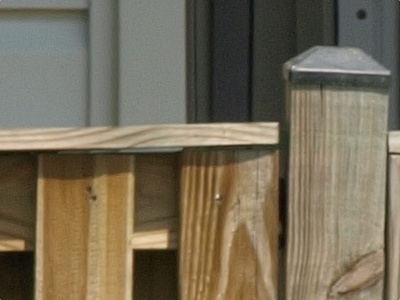
| |
| [5d] 420 mm, 1/60 s at F/16 | ||
|
F = 500 mm Finally, we arrived to the real reason why you've been considering this lens: the long focal length of 500 mm, the justification for lugging these four pounds along. On the other hand, we should not be complaining. For this image angle just 20 years ago you would have to carry a 1000 mm lens; at the maximum aperture of F/8 this would be five or six kilos. |
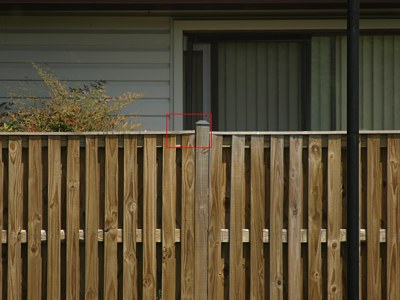
|
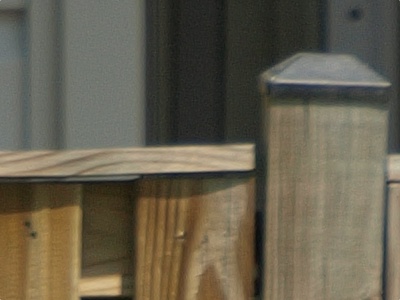
| |
| [6a] 500 mm, 1/400 s at F/6.3 | ||
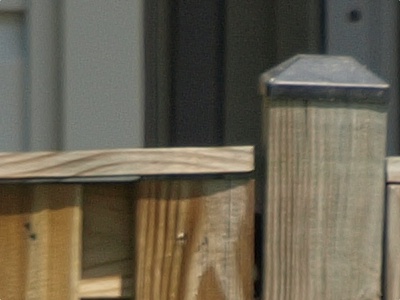
|
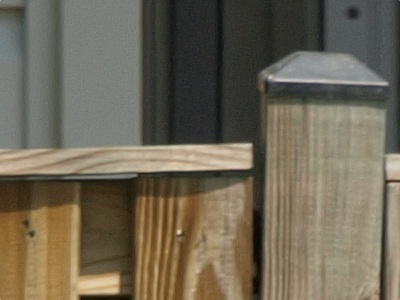
| |
| [6b] 500 mm, 1/250 s at F/8 | [6c] 500 mm, 1/125 s at F/11 | |
|
Again, a bit soft fully open, good at F/8, better at F/11. Just compare the wood texture. Definitely, shooting at F/8 or F/11 would be a good idea. By the way, the fence is at the distance of about 80 meters from the camera; the depth of field extends by about three meters each way at F/8, which is not quite deep enough to include the patio door behind. (The DoF range has been computed for a 0.015 mm circle of confusion, about 1/1440 of frame diagonal. This is a tad more than three pixels in the E-510, what gives us some idea of the acceptable fuzz in the 1:1 samples.) The full, original JPEG file of the F/8 image is available for your inspection. |
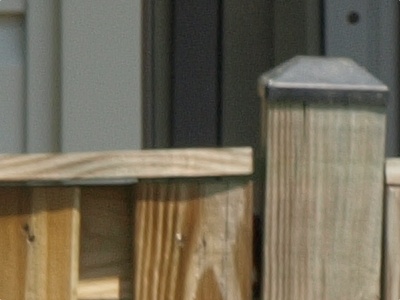
[5d] 500 mm, 1/60 s at F/16 | |
|
Things are rarely as simple as they seem to be. My lake series, while quite satisfactory, does not seem to be as sharp as the previous one. This may be partly due to the subject choice, but I also suspect the lens, when used on my E-510, suffers from a slight front focus problem, at least at 400 and 500 mm. The black lantern in front of the fence seems, when you look at the full frames (see links above), sharper than the fence itself. This may be an effect of its being black (higher contrast on the bright fence background, less of the scattered light effect), but this is probably real. Well, in this kind of tests you are not checking the performance of the lens alone, but rather that of the whole system: lens, camera, and photographer. This spring, if and when I put my hands again on the Bigma, I'm going to investigate the affair. More samples A few more sample images; all pictures were shot with an E-510, handheld in aperture priority mode, with sharpness and contrast at N-1, IS on, noise filtering off, except as stated in captions. |
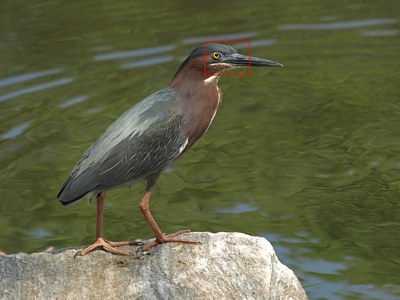
|
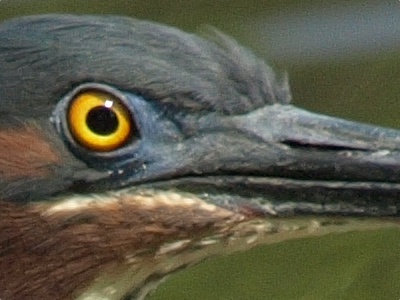
| |
| 500 mm, 1/250 s at F/9.0 | ||
|
This one is as good as they come off a 500 mm lens. At 1/250 s I was at risk of camera shake, but the Olympus in-body IS helped, and with the aperture of F/9 the picture is nailed. With in-camera sharpening tuned way down, and noise filtering off, there is lot of room for tweaking it in postprocessing. Judge for yourself: here is the full frame (4.3 MB), postprocessed: black level moved down, moderate noise removal and some directional sharpening (not the Unsharp Mask, which I find too intrusive). Please use the picture (and any others here) for your personal enjoyment only; any other use, for profit or not, requires my written permission. The green heron was quite cooperative, listening to a teenager, who was singing a Stones' song from the Seventies and playing his ukulele a few feet away (no, I'm not inventing this!), so I had some time to shoot more, changing the settings. Here is another frame: |
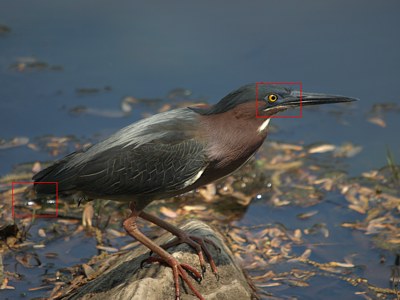
|
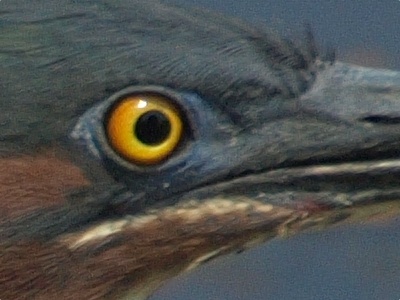
| |
| 500 mm, 1/640 s at F/6.3 | ||
|
Why am I showing you this one? First, this is at full aperture, and you can see that: the sharpness is passable, but not as good as above (I shot six frames at this aperture, so this is not a focusing problem). Also, it looks like with all this glass, the scattered light dilutes the blacks more than at F/9, but this is a minor fix in postprocessing.
A more important problem is, if you excuse me, under the bird's tail; see the fragment at the right. The out-of-focus highlights take an ugly doughnut shape, not unlike in a mirror lens. This is definitely not nice, but it doesn't happen often. |
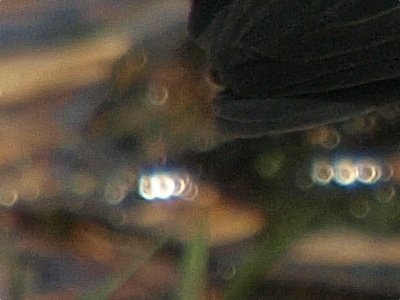
| |
| Another fragment of the sample above | ||
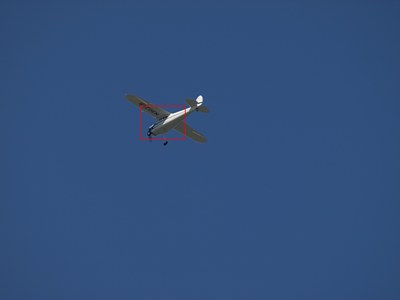
|
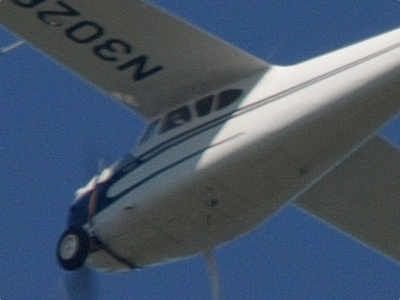
| |
| 500 mm, 1/320 s at F/9 | ||
|
This image does not say much about the lens; still, it is typical to what you may be getting at this focal length. Focusing while following the subject, possible camera shake, plus the lens itself — all of this adds together. |
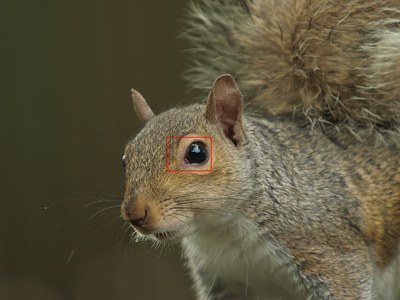
|
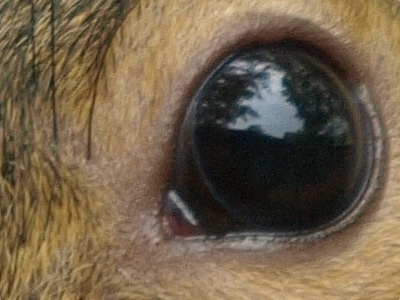
| |
| 337 mm, 1/60 s at F/6.3 | ||
|
This was quite late in the afternoon, note the handheld exposure of 1/60 s. Near 300 mm the fully-open Bigma does better than at the long end. Again, check the full frame (postprocessed) to see what you can get from this lens. At about 3.5 m, the depth of field extends for about 1 cm in each direction; focused on the eye it will accommodate the ear and whiskers, but blurring the background (trees about 20 ft behind the squirrel) quite pleasantly. |
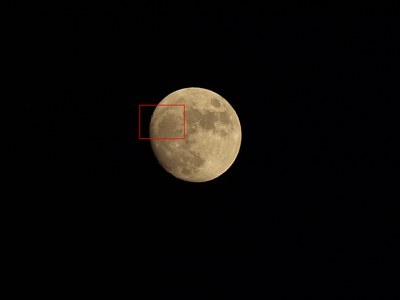
|
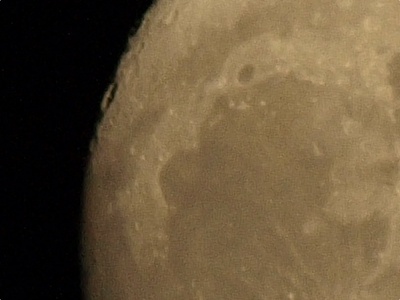
| |
| 500 mm, manual exposure: 1/400 s at F/7.1 | ||
|
While the detail could be better here (I should have stepped the lens down one more F-stop), the Moon picture does not show even traces of chromatic aberration at the disk edge. True, this is quite close to the center, but I've seen this problem in quite a few lenses in my past Moon shots. Have a look at a 960×1280 crop (no resizing) from a postprocessed frame: contrast and color adjustment, noise removal, and sharpening. Compared to... I do not have much to compare these images with. One comparison which can be done, though, is against the 70-300 mm ZD at 300 mm. Because that lens has a wider maximum aperture at 300 mm (1/3 EV of a difference), here are samples at that length and F/8.
Different light and different exposure make direct comparison not so simple, but I have no doubt that the Bigma is sharper, if just by a little. And it better be: at more than triple the price (as of February, 2009). You have to remember, though, that 300 mm is Bigma's "sweet spot". Conclusions The Bigma remains the only option for Olympus SLR users who need a 500 mm focal length; the closest alternative would be the 50-200 mm F/2.8-3.5 ZD used with the EC-20 teleconverter, resulting in a 100-400 mm F/5.6-7.0 combination. This is 20% shorter and 1/3 EV darker, but worth consideration (I haven't checked how well this combination performs optically). Another alternative is the 70-300 mm F/4.0-5.6 ZD, at less than third of the Bigma price, but with just 60% of its reach. Easier to use (shorter focal length) this one delivers surprisingly good results, not just at the price. It usually will be a better choice for someone not really experienced with long lenses (like myself). As a long tele zoom, the lens performs as expected: good, but not great. It delivers best, I would say, between 200 and 300 mm, and worst at 400-500 mm; at every focal length it works better closed down to F/8, and near the long end — perhaps down to F/11 (whatever is lost due to diffraction effects is less than what is gained by reducing other aberrations). I suspect that the limitations in image quality have their source in the "DG" (full-frame legacy) nature of the lens. The resolution it delivers may be impressive when used on a full 24×36 mm frame; to render the same detail on a Four Thirds sensor, requiring twice the magnification of the original image, it would need twice its real resolution. (Do not expect much improvement on cameras with an APS-C sensor, as the frame height differs by just 15%; not enough.) On the other hand, the Four Thirds sensor uses only the central 25% of the lens coverage area, where the performance is usually at its best. Still, lens design is a compromise between central and peripheral resolution and here we are paying the price for the part which we do not use. This said, when the camera gets the autofocus right with this lens, it will deliver images with more detail than the 70-300 mm ZD I like so much (again, note the "when" in this sentence). The other lens, however, sells for less than third the price and weighs just a third, too. (Do they charge by weight nowadays?) Many such lenses rapidly lose contrast as the focal length increases, mostly due to internal light reflection and diffusion. The Bigma performs admirably here; while in some samples I could notice the luminosity histogram starting higher than it should, the effect was not strong, and it is easy to correct. (Things become, obviously, different when shooting against the light.) There are no autoexposure problems on Olympus bodies I've checked (and this was not a given); the autofocus works OK, if sometimes with hesitation and, I (just) suspect, not always accurately. Out of three frames I was shooting for every sample image, usually I could easily spot one lacking focus accuracy; in some cases even two. (In this aspect, the 70-300 mm ZD seems to be doing a better job. Perhaps to much glass to move?) When properly and carefully used, the lens can deliver very pleasing images, easily printable to 12×16", or 30×40 cm. Note the "properly and carefully" clause above; it is important: used casually this lens will disappoint (as will any other at this focal length). Still, patience and skill will be rewarded with some images not possible with any other glass on E-System bodies. (Yes, I know about legacy lenses, but here I mean only those fully cooperating with the camera.) Myself, I decided to wait for an affordable (mid-priced) prime 500 mm F/5.6 or F/6.3 from Olympus, or a 400 mm F/5.6. No, there are no rumors on anything like this, but I think it would fix a gap on the market. In the meantime, I'm enjoying my ridiculously inexpensive 70-300 mm F/5.0-5.6 ZD (ironically, also based on a Sigma DG design, and probably made by Sigma as well), and trying to master long-lens techniques. Adding all this up, I can recommend this lens — but only to people who really need it, and who will know how to use it. References Most image galleries and reports in the Bigma which I could find show only reduced-size images from this lens, a few hundred pixels across. This is not enough to judge the lens quality, if OK to illustrate the possibilities offered by this image angle. What you just went through may be so far the most comprehensive collection of real image samples, as flawed as they may be. Besides, there are not so many factual write-ups of Bigma on the Web; most are just buyers' general opinions like "great lens, I just love it" or, less often, "this lens stinks, couldn't get one sharp picture". These are links to some interesting pieces of information or images I was able to find.
|

|
My other articles related to the |
|
Olympus® is a registered trademark of Olympus Corporation.
This page is not sponsored or endorsed by Olympus (or anyone else) and presents solely the views of the author. |
| Home: wrotniak.net | Search this site | Change font size |
| Posted 2006/09/24; completed 2009/02/16; last updated 2009/02/28 | Copyright © 2006-2009 by J. Andrzej Wrotniak |